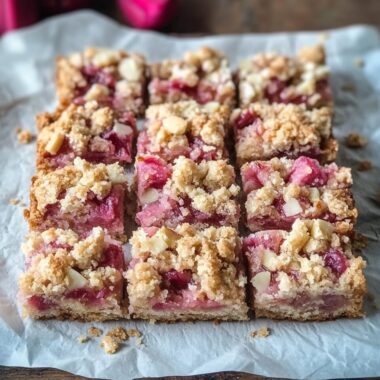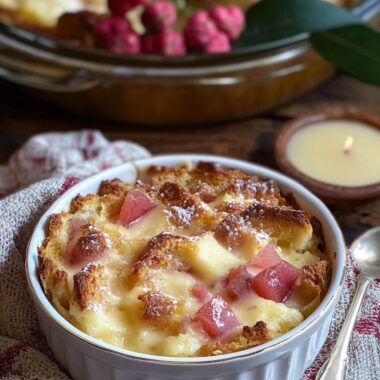These Rhubarb Fritters are a fun and delicious twist on the classic apple version. With their slightly tart filling and rich, golden dough, they strike the perfect balance between sweet and tangy. The fresh rhubarb keeps its texture, adding an unexpected crunch to every bite.
Perfect for spring and early summer, these fritters are ideal for brunch tables, garden parties, or as a nostalgic weekend bake. The lemon glaze enhances the brightness of the rhubarb and gives these fluffy, chewy pillows of dough their irresistible finishing touch.
Full recipe:
Ingredients:
For the Dough:
-
4–5 cups all-purpose flour (divided)
-
1/4 tsp baking soda
-
1 tsp salt
-
Pinch of ground nutmeg
-
1 cup warm buttermilk
-
1/4 cup melted butter
-
2 large eggs
-
1/2 cup granulated sugar
-
1 Tbsp active dry yeast
For the Rhubarb Filling:
-
3 cups finely diced rhubarb
-
1/2 cup granulated sugar
-
3 Tbsp lemon juice
-
Pinch of salt
For Frying:
-
About 1 liter oil for deep frying
For the Glaze:
-
Reserved liquid from rhubarb mixture
-
2 cups icing sugar
-
Extra lemon juice, if needed
Directions:
-
In a mixing bowl, whisk 2 cups of flour with baking soda, salt, and nutmeg. Set aside.
-
In the bowl of a stand mixer, combine buttermilk, melted butter, eggs, sugar, and yeast. Mix on low for 1 minute.
-
Add in the dry mixture and whisk again for 1 minute. Switch to a dough hook and add enough additional flour (about 1½ cups) to form a soft, non-sticky dough.
-
Knead the dough for 5 minutes. Transfer to an oiled bowl, cover, and let rise in a warm place for 1 to 1½ hours until doubled in size.
-
While the dough rises, mix rhubarb, sugar, lemon juice, and salt in a bowl. Let sit for at least an hour. Drain and reserve the liquid for the glaze.
-
After rising, roll the dough into a 1/2-inch thick rectangle. Spread rhubarb on half of the dough. Fold the other half over and gently roll flat again.
-
Cut into 20 pieces. Twist and flatten each piece slightly. Place on individual squares of parchment paper on a baking sheet. Cover and let rise again for 1 hour.
-
Heat oil to 350°F (use a thermometer). Prepare glaze by whisking reserved rhubarb liquid with icing sugar, adding lemon juice if needed for consistency.
-
Fry 3–4 fritters at a time for 1 minute per side, or until golden brown. Drain on paper towels or a wire rack.
-
While warm, dip each fritter into glaze and let excess run off. Serve warm, room temp, or chilled.
Prep Time: 2 hours | Cooking Time: 15 minutes | Total Time: 2 hours 15 minutes
Kcal: ~290 kcal per fritter | Servings: 20 fritters
A Sweet Twist on Tradition: The Origins of Rhubarb Fritters
Rhubarb fritters are a unique and delicious variation on the classic apple fritter—a beloved deep-fried pastry that has found its place in bakeries and breakfast spots across North America. The roots of fritters can be traced back to early European cooking, where frying dough was a common technique to create satisfying, portable treats. Over time, apple fritters became the go-to version, thanks to their comforting blend of sweetness and spice. But rhubarb offers a delightful twist.
Rhubarb has a long history in culinary traditions, especially in the UK and parts of Europe where it is often used in pies, crumbles, and preserves. Known for its intense tartness, rhubarb pairs beautifully with sugar and citrus to create a well-balanced flavor. When folded into soft, pillowy dough and fried to a golden crisp, rhubarb transforms into something magical—both familiar and refreshingly new.
Why Rhubarb? Unique Flavor and Seasonal Appeal
What makes rhubarb fritters so special is the ingredient itself. Rhubarb is a spring vegetable, although it’s often treated as a fruit in baking due to its tangy flavor. It brings a natural acidity that balances the richness of the dough and the sweetness of the glaze. Unlike apples, rhubarb retains some of its firmness even after cooking, lending a delightful contrast in texture to the soft interior of the fritter.
For many, rhubarb evokes childhood memories of rhubarb pies, jam, and backyard gardens. Incorporating it into fritters introduces a touch of nostalgia while offering a new take on an old favorite. And because rhubarb is seasonal, these fritters feel like a special treat—perfect for spring gatherings, brunches, or as a way to showcase your garden harvest.
The Benefits of Making Rhubarb Fritters at Home
There’s something incredibly rewarding about making fritters from scratch. While the process requires a bit of time—thanks to the yeast dough and resting periods—the final result is incomparable to anything store-bought.
Control Over Ingredients: You can adjust the sweetness, switch to whole grain flours, or even experiment with other fillings.
Freshness: Store-bought pastries can never compare to the warm, melt-in-your-mouth experience of a freshly fried fritter.
Customization: Add a touch of cinnamon, a sprinkle of cardamom, or even orange zest to elevate the flavor profile further.
Cost-Effective: Buying rhubarb in season and using pantry staples means this treat is both affordable and satisfying.
Plus, making fritters at home gives you the joy of creating something special with your hands. It’s the perfect weekend baking project—fun to make, shareable, and always a crowd-pleaser.
Texture, Flavor, and Balance: What Makes This Recipe Stand Out
This specific rhubarb fritter recipe stands out for its masterful balance of flavor and texture. The dough is light yet sturdy enough to encase juicy bits of rhubarb. It’s slightly sweet, with a hint of nutmeg that adds warmth and depth. The addition of buttermilk in the dough provides a tender crumb, while the glaze, made from the rhubarb’s own juices and a splash of lemon, ties everything together with a bright, zesty finish.
The fritters are fried to a golden brown, giving a crisp shell that yields to a soft, chewy center. The rhubarb chunks burst with flavor, offering little pockets of tartness that keep the sweet dough from becoming too rich. Dipping the warm fritters into the tangy glaze allows it to seep into the crevices, ensuring each bite is perfectly coated.
Tips for Success and Variations to Explore
To get the best results from this recipe, here are a few tips:
- Use Fresh Rhubarb: Freshly harvested stalks are ideal. Look for firm, brightly colored stalks without too much stringiness.
- Don’t Overcrowd the Oil: Fry in small batches to maintain oil temperature and ensure even cooking.
- Use a Thermometer: Oil that’s too hot will burn the outside while leaving the inside raw. Keep it around 350°F (175°C).
- Make the Glaze in Advance: This allows you to quickly dip the fritters while they’re still warm and ready to absorb that zesty goodness.
If you’re looking to mix things up, here are some fun variations:
- Add Spices: A dash of cinnamon, ginger, or cardamom can complement the rhubarb beautifully.
- Include Other Fruits: Mix in strawberries, raspberries, or blueberries with the rhubarb for a mixed berry fritter.
- Make It Vegan: Replace the eggs and buttermilk with plant-based alternatives like flax eggs and almond milk with lemon juice.
- Air Fry or Bake: For a lighter version, try air-frying or oven-baking the fritters. While the texture will differ, the flavor remains delicious.
Perfect for Sharing and Celebrating
Whether you’re celebrating a springtime brunch, preparing treats for a weekend picnic, or simply indulging in a homemade dessert, these fritters are perfect for the occasion. Their visual appeal—golden brown, slightly rustic, and dripping with glaze—makes them an eye-catching centerpiece. You can stack them on a platter with lemon slices and powdered sugar for a charming bakery-style presentation.
Fritters are also great for gifting. Pack them up in a cute box or wrap them in parchment and twine for a homemade present that feels thoughtful and special.
How to Store and Reheat Rhubarb Fritters
Rhubarb fritters are best enjoyed fresh, but they can be stored for a short time without losing too much quality. Here’s how:
- To Store: Keep leftovers in an airtight container at room temperature for up to 2 days.
- To Reheat: Place in a 300°F (150°C) oven for 5–7 minutes to refresh the texture. Avoid microwaving as it can make them soggy.
- Freezing: If you plan to freeze them, do so before glazing. Let them cool completely, place them in a single layer in a freezer bag, and store for up to 2 months. Reheat in the oven and glaze before serving.
Why This Recipe Is a Must-Try
This rhubarb fritter recipe stands out for its balance of flavor, satisfying texture, and beautiful presentation. The combination of homemade yeast dough and tart rhubarb creates a pastry that’s comforting yet refreshing. It’s a great way to celebrate seasonal produce while indulging in something sweet and soul-warming.
Compared to store-bought fritters or other desserts, these offer a more dynamic experience—crispy, chewy, tangy, and sweet—all in one bite. Whether you’re a rhubarb lover or just looking for something new, this recipe deserves a spot in your go-to collection.
Conclusion
From blog readers to recipe testers, people love this twist on the classic fritter:
- “These were gone within an hour of making them. The texture is unbelievable—soft inside and that crunch of rhubarb is amazing!”
- “I’ve made apple fritters many times, but rhubarb has officially won me over. The glaze is so lemony and refreshing.”
- “I tried them in the air fryer and they still turned out really nice! The glaze was everything.”
So, if you’re on the fence about rhubarb or have only used it in pies, give these fritters a try. They just might become your new spring favorite.







